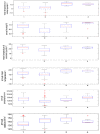Predicting the Global Potential Distribution of Four Endangered Panax Species in Middle-and Low-Latitude Regions of China by the Geographic Information System for Global Medicinal Plants (GMPGIS)
- PMID: 28956837
- PMCID: PMC6151741
- DOI: 10.3390/molecules22101630
Predicting the Global Potential Distribution of Four Endangered Panax Species in Middle-and Low-Latitude Regions of China by the Geographic Information System for Global Medicinal Plants (GMPGIS)
Abstract
Global biodiversity is strongly influenced by the decrease in endangered biological species. Predicting the distribution of endangered medicinal plants is necessary for resource conservation. A spatial distribution model-geographic information system for global medicinal plants (GMPGIS)-is used to predict the global potential suitable distribution of four endangered Panax species, including Panax japonicas (T. Nees) C. A. Meyer and Panax japonicas var. major (Burkill) C. Y. Wu & K. M. Feng distributed in low- and middle-latitude, Panax zingiberensis C. Y. Wu & K. M. Feng and Panax stipuleanatus C. T. Tsai & K. M. Feng in low-latitude regions of China based on seven bioclimatic variables and 600 occurrence points. Results indicate that areas of P. japonicus and P. japonicusvar. major are 266.29 × 10⁵ and 77.5 × 10⁵ km², respectively, which are mainly distributed in China and America. By contrast, the areas of P. zingiberensis and P. stipuleanatus are 5.09 × 10⁵ and 2.05 × 10⁵ km², respectively, which are mainly distributed in Brazil and China. P. japonicus has the widest distribution among the four species. The data also indicate that the mean temperature of coldest quarter is the most critical factor. This scientific prediction can be used as reference for resource conservation of endangered plants and as a guide to search for endangered species in previously unknown areas.
Keywords: Panax; geographic information system for global medicinal plants (GMPGIS); global potential distribution.
Conflict of interest statement
The authors declare no conflict of interest.
Figures








Similar articles
-
Prediction of the globally ecological suitability of Panax quinquefolius by the geographic information system for global medicinal plants (GMPGIS).Chin J Nat Med. 2019 Jul;17(7):481-489. doi: 10.1016/S1875-5364(19)30069-X. Chin J Nat Med. 2019. PMID: 31514979
-
[Prediction of global potential growth areas for Panax ginseng based on GMPGIS system and MaxEnt model].Zhongguo Zhong Yao Za Zhi. 2023 Sep;48(18):4959-4966. doi: 10.19540/j.cnki.cjcmm.20230514.102. Zhongguo Zhong Yao Za Zhi. 2023. PMID: 37802837 Chinese.
-
Resource investigation of traditional medicinal plant Panax japonicus (T.Nees) C.A. Mey and its varieties in China.J Ethnopharmacol. 2015 May 26;166:79-85. doi: 10.1016/j.jep.2015.02.051. Epub 2015 Mar 12. J Ethnopharmacol. 2015. PMID: 25771357
-
Identification of certain Panax species to be potential substitutes for Panax notoginseng in hemostatic treatments.Pharmacol Res. 2018 Aug;134:1-15. doi: 10.1016/j.phrs.2018.05.005. Epub 2018 May 15. Pharmacol Res. 2018. PMID: 29772270 Review.
-
[Research progress on geographic distribution new records of medicinal plants in Guizhou].Zhongguo Zhong Yao Za Zhi. 2008 Mar;33(5):594-7. Zhongguo Zhong Yao Za Zhi. 2008. PMID: 18536388 Review. Chinese.
Cited by
-
A new GIS model for ecologically suitable distributions of medicinal plants.Chin Med. 2019 Feb 20;14:4. doi: 10.1186/s13020-019-0226-0. eCollection 2019. Chin Med. 2019. PMID: 30828359 Free PMC article.
-
Maximum Entropy Modeling to Predict the Impact of Climate Change on Pine Wilt Disease in China.Front Plant Sci. 2021 Apr 23;12:652500. doi: 10.3389/fpls.2021.652500. eCollection 2021. Front Plant Sci. 2021. PMID: 33968109 Free PMC article.
-
Modeling habitat distribution and niche overlap of Asian horseshoe crabs: Implications for conservation.PLoS One. 2025 May 28;20(5):e0324471. doi: 10.1371/journal.pone.0324471. eCollection 2025. PLoS One. 2025. PMID: 40434990 Free PMC article.
-
Prediction of Suitable Habitat Distribution of Cryptosphaeria pullmanensis in the World and China under Climate Change.J Fungi (Basel). 2023 Jul 11;9(7):739. doi: 10.3390/jof9070739. J Fungi (Basel). 2023. PMID: 37504728 Free PMC article.
-
An Integrated LC-MS-Based Strategy for the Quality Assessment and Discrimination of Three Panax Species.Molecules. 2018 Nov 15;23(11):2988. doi: 10.3390/molecules23112988. Molecules. 2018. PMID: 30445785 Free PMC article.
References
-
- Rai A., Yamazaki M., Takahashi H., Nakamura M., Kojoma M., Suzuki H., Saito K. RNA-seq Transcriptome Analysis of Panax japonicus, and Its Comparison with Other Panax Species to Identify Potential Genes Involved in the Saponins Biosynthesis. Front. Plant Sci. 2016;7:e0144. doi: 10.3389/fpls.2016.00481. - DOI - PMC - PubMed
MeSH terms
LinkOut - more resources
Full Text Sources
Other Literature Sources

